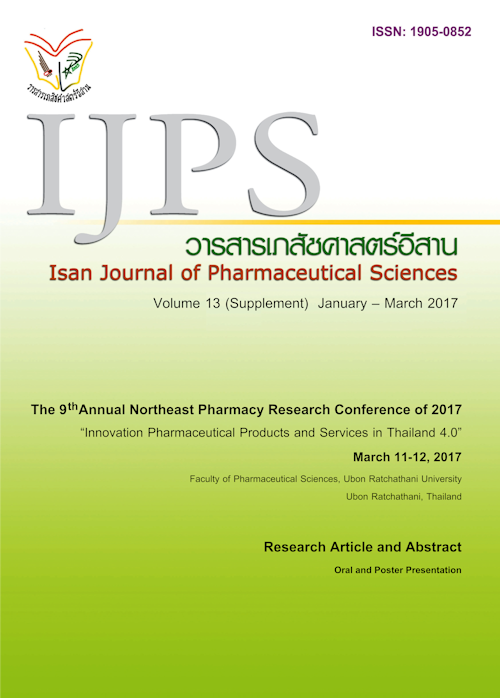ฤทธิ์ต้านอนุมูลอิสระและปริมาณสารประกอบฟีนอลิกรวม ของตำรับยาแผนโบราณบางตำรับ
Main Article Content
บทคัดย่อ
บทนำ: สารต้านอนุมูลอิสระสามารถลดปริมาณอนุมูลอิสระและโมเลกุลที่ประกอบด้วยอะตอมของออกซิเจนที่พร้อมเข้าทำปฏิกิริยาในร่างกายได้ ยาสมุนไพรและยาแผนโบราณมีฤทธิ์ต้านอนุมูลอิสระที่ดี ตำรับยา แผนโบราณประกอบด้วยสมุนไพรหลายชนิดและปริมาณที่แตกต่างกัน ซึ่งสามารถรักษาได้หลายโรค ได้แก่ระบบ ทางเดินอาหาร ระบบหัวใจและหลอดเลือด ระบบทางเดินหายใจ ระบบไหลเวียนโลหิต ระบบกล้ามเนื้อและกระดูก และบำรุงร่างกาย ฯลฯ มีตำรับยามากมายที่ใช้ในประเทศไทยมาอย่างยาวนาน ได้แก่ ยาหอม ยากษัยเส้น ยาเขียวหอม และยาลม วัตถุประสงค์ของการวิจัยนี้คือเพื่อศึกษาฤทธิ์ด้านอนุมูลอิสระและปริมาณสารประกอบ ฟีนอลิกรวมของตำรับยาแผนโบราณ 7 ตำรับ วิธีดำเนินการวิจัย: การทดสอบฤทธิ์ด้านอนุมูลอิสระโดยวิธี ABTS assay และหาปริมาณสารประกอบฟีนอลิกรวมด้วยวิธี Folin-ciocalteu ผลการวิจัย: จากผลการทดลอง พบว่าตำรับยา A แสดงสมบัติด้านอนุมูลอิสระสูงที่สุด (IC50 1.60 มิลลิกรัมต่อมิลลิลิตร) ขณะที่ตำรับยา F มี ฤทธิ์ต้านอนุมูลอิสระน้อยที่สุด (IC5017.11มิลลิกรัมต่อมิลลิลิตร) ร้อยละของการยับยั้งการดูดกลืนแสงของ ABTS+เพิ่มขึ้นตามความเข้มข้นของตำรับยาแผนโบราณ ตำรับยา A มีปริมาณสารประกอบฟีนอลิกรวมสูงสุด (897.78 มิลลิกรัมกรดแกลลิคต่อกรัมน้ำหนักแห้ง) ขณะที่ตำรับยา G มีปริมาณสารประกอบ ฟีนอลิกรวมตํ่าสุด (158.15 มิลลิกรัมกรดแกลลิคต่อกรัมน้ำหนักแห้ง) สรุปผลการวิจัย: ตำรับยาแผนโบราณ ทั้ง 7 ชนิดแสดงสมบัติด้านอนุมูลอิสระและมีสารประกอบฟีนอลิกเป็นองค์ประกอบตำรับยา A ประกอบด้วย จันทน์แดง โกศหัวบัว ดอกมะลิ ดอกพิกุล ดอกบุนนาค ดอกสารภี และเกสรบัวหลวง เป็นตำรับที่มีฤทธิ์ต้านอนุมูลอิสระและมีสารประกอบฟีนอลิกรวมสูงกว่ายาแผนโบราณตำรับอื่น ดังนั้นองค์ประกอบในตำรับยา A จึงน่าสนใจที่จะศึกษาฤทธิ์ต้านอนุมูลอิสระและฤทธิ์ทางชีวภาพอื่นๆ ต่อไป
Article Details
กรณีที่ใช้บางส่วนจากผลงานของผู้อื่น ผู้นิพนธ์ต้อง ยืนยันว่าได้รับการอนุญาต (permission) ให้ใช้ผลงานบางส่วนจากผู้นิพนธ์ต้นฉบับ (Original author) เรียบร้อยแล้ว และต้องแนบเอกสารหลักฐาน ว่าได้รับการอนุญาต (permission) ประกอบมาด้วย
เอกสารอ้างอิง
Channarong S, Jutiviboonsuk A, Korsanan S. Total reducing antioxidant capacity of Thai herbal aromatic powder (Ya-hom) measured by FRAP assay. Thai Pharm Health Sci J.2012, 7(3):111-114.
Halliwell B. Antioxidants in human health and disease. Annu Rev Nutr. 1996, 16: 33-50.
Luanchoy S, Tiangkul S, Wongkrajang Y, Temsiririrkkul R, Peungvicha P, Nakornchai S. Antioxidant activity of a Thai traditional formula for longevity. Mahidol Univ J Pharm Sci. 2014, 41(3): 1-5.
Manok S, Limcharoen P. Investigating antioxidant activity by DPPH, ABTS and FRAP assay and total phenolic compounds of herbal extracts in Ya-Hom Thepphachit. Advanced Science. 2015, 15(1): 106-117.
Nawar WF. Lipids. In: Fennema O, editor. Food chemistry. 3rd ed. New York: Marcel Dekker, Inc.1996, p 225-320.
Re R, Pellegrini N, Proteggente A, Pannala A, Yang M, Rice-Evans C. Antioxidant activity applying an improved ABTS radical cation decolorization assay. Free Radical Bio Med. 1999, 26: 1231-1237.
Regoli F. Total oxyradical scavenging capacity (TOSC) in polluted and translocated mussels a predictive biomarker of oxidative stress. Aqua Toxicol. 2000, 50: 351-361.
Rice-Evans CA, Miller NJ, Paganga G. Antioxidant properties of phenolic compounds. Trends Plant Sci. 1997, 2: 152-159. Rubalya VS, Neelamegam P. Antioxidant potential in vegetable oil. ResJ ChemEnviron. 2012,16(2): 87-94.
Shalaby EA, Shanab SMM. Comparision of DPPH and ABTS assays for determining antioxidant potential of water and methanol extracts of Spirulina platensis. Indian J Mar Sci. 2013, 42(5): 556-564.
Su L, Yin J, Charls D. Total phenolic contents chelating capacities, and radical scavenging properties of black peppercorn, nutmeg, rosehip, cinnamon and oregano leaf. Food Chem. 2007,100: 990-997.
Suwangasawong W. Reporting Report of adverse drug reaction/adverse drug events from herbal product / Thai traditional drug during 2006-2015, Medicinal Health Product Bulletin. 2016, 19(3): 88-96.
Tuekaew J, Siriwatanametanon N, Wongkrajang Y, Temsiririrkkul R, Jantan I. Evaluation of the antioxidant activities of Ya-HomIntajak, a Thai herbal formulation, and its component plants. Trop J Pharm Res. 2014, 13(9): 1477-1485.
Yan SW, Asmah R. Comparison of total phenolic contents and antioxidant activities of turmeric leaf, pandan leaf and torch ginger flower. Int Food Research J.2010, 17: 417-423.


